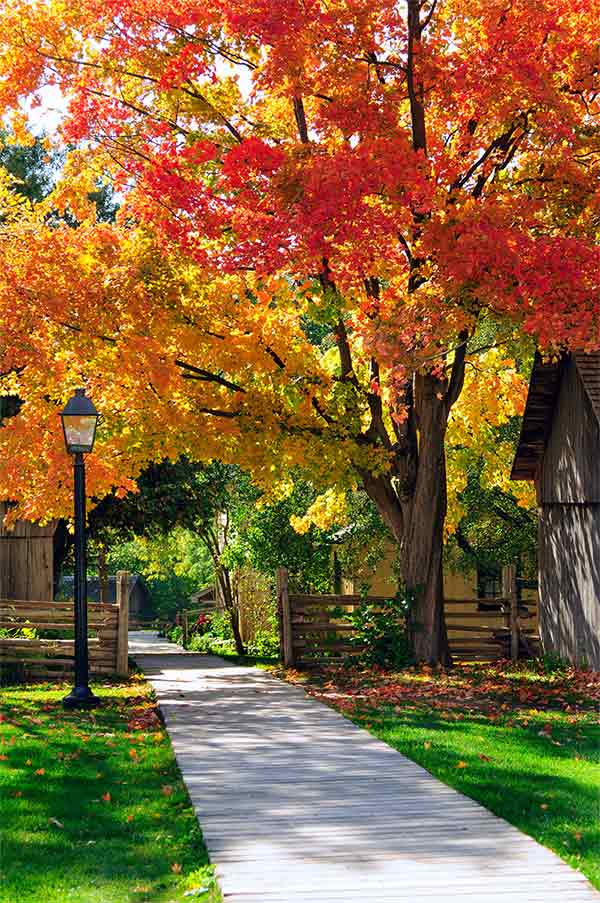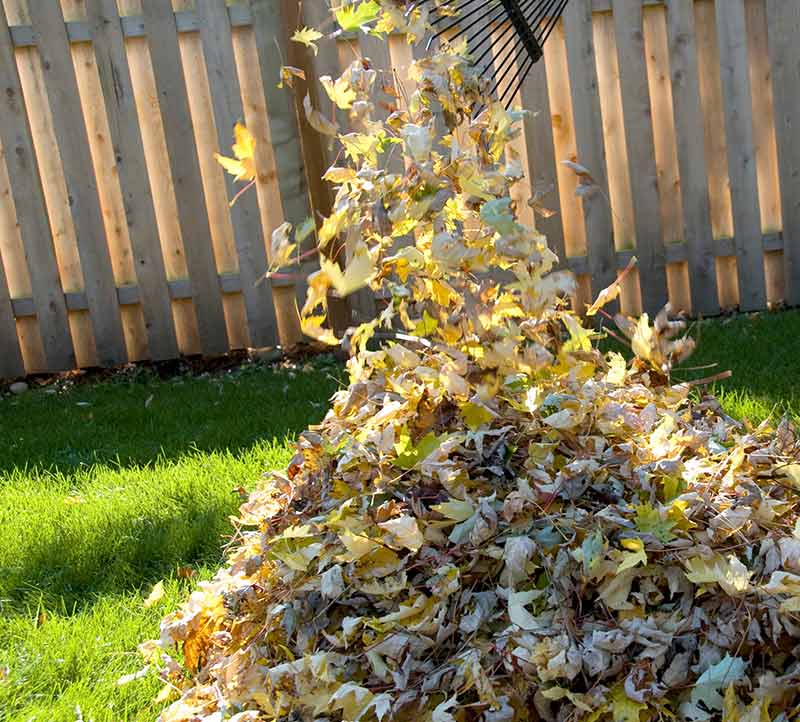Fall Lawn Maintenance Tips
With lawn care high on the list of things you take pride in, autumn is no time to relax. There's plenty of leisure time ahead, but now's the time to finish the season strong. Check your way through the following lists, based on the type of grass you grow. You can get a jump on spring and help set your neighborhood's bar for lawn care a little higher for next year.
Fall Tasks for Cool-Season Lawns

As temperatures drop in late summer and early fall, cool-season grasses peak in growth. These grasses include northern favorites such as Kentucky bluegrass, perennial ryegrass and tall and fine fescues. Warm days and cool nights make fall the perfect time for establishing new grass and strengthening existing lawns. The following fall tasks help cool-season lawns flourish:
- Test your soil. Fall soil testing helps take the guesswork out of managing your lawn's soil pH and nutrition. By making recommended improvements in fall, soil amendments have extra time to complete their work and prepare your soil before spring. Applications of Pennington Fast Acting Lime, for example, immediately start working to restore balance to soil pH and encourage healthier, greener lawns come spring. Test healthy lawns every three to four years, but test problem areas every year.
- Feed your lawn. Fall fertilizing varies from your regular-season plan. With summer dormancy behind them, cool-season grasses benefit from fertilizing about six weeks before your first expected frost.1 A high-nitrogen fertilizer, such as Pennington Full Season Lawn Fertilizer 32-0-5, helps lawns establish vigorous roots, increase energy reserves and survive winter.
- Overseed thin lawns. Fall conditions are ideal for germinating cool-season grass seed. Overseeding thin lawns pays off with thick, strong, spring grass. Overseed at least 45 days before anticipated frost, so grass gets established before colder weather.2
- Repair bare spots. With soil test recommendations complete, problem bare spots are ready for repair. Fall temperatures and precipitation support quick establishment. Pennington Smart Patch II mixes simplify repairs by combining premium seed, professional-grade fertilizer and mulch — everything you need in a single, easy-to-use product.
- Remove excess thatch. That layer of organic matter that forms between soil and grass blades can benefit lawns when it's thin. But when that layer, known as thatch, builds up to more than 1/2 inch thick, it can limit the movement of water and nutrients and encourage disease. Dethatching tools range from handheld rakes to power equipment called dethatchers or vertical mowers. These tools work to cut into the thatch layer, pull it up for removal, and restore a healthy interface between grass and soil.
- Aerate compacted soil. Compacted soil restricts root development and limits soil oxygen. Aerators correct compaction by creating openings in the soil, and encompass tools from footwear with spikes on the soles to highly effective machines called core aerators. Core aerators improve compaction by removing small plugs or cores of your lawn. Plugs break down on the surface, while the holes they leave invite air, water and nutrients in. As with dethatching, core aeration should correspond to active fall growth.
- Keep watering. Actively growing, cool-season grass needs water. But as fall approaches, you can stretch out regular watering and let rainfall help. Healthy, established lawns generally need 1 inch of water, including precipitation, weekly. As growth slows, that same amount may cover 10 to 14 days, under normal conditions.3
- Keep mowing. Continue with good mowing practices for your grass type, timed to grass growth instead of calendar days. Mowing grass slightly shorter than normal can be helpful where winter fungal diseases are problems, but don't save it for the end; gradually decrease the height instead.3
- Control weeds. With weeds still going strong in early fall, a fall application of Pennington Full Season Weed & Feed with Crabgrass Control 25-0-8 helps eliminate these plant pests. Use weed & feed only on established cool-season lawns, and avoid newly seeded areas. Tackle tough weeds with targeted spot treatments.3
- Clean up leaves. Left untended, mats of fallen leaves suffocate lawn grasses and invite disease. Mow and mulch small quantities of leaves, but rake, bag or compost large quantities.
Fall Tasks for Warm-Season Lawns
Cool fall temperatures signal warm-season grasses that their peak time has passed. These grasses, such as bermudagrass, centipede grass, zoysia grass and bahiagrass, experience their most active growth in summer and enter dormancy with fall's killing frost. Because they're slowing down in fall, warm-season grasses need different care from their cool-season counterparts. The following fall tasks keep warm-season lawns on track:

- Test your soil. Fall soil testing benefits lawns, regardless of your grass type. Put test results to use by following recommendations for corrections, and you'll be ahead of the game in spring.
- Stop fertilizing. Time your last lawn feeding for six to eight weeks before your first fall frost.1 For Bermudagrass, four to five weeks before the frost date is fine. Fertilizing any later can interfere with the natural progression of dormancy and leave your lawn vulnerable in winter.
- Overseed for winter color. Circumvent a brown, dormant lawn by overseeding with a cool-season grass, such as Pennington Smart Seed Perennial Ryegrass Grass Seed and Fertilizer Blend that stays green during winter months. Wait until night temperatures drop and warm-season grass starts losing color. Hold off on overseeding just for thinning; do that in spring when active growth returns.
- Skip dethatching and aerating. Dethatching and aerating can help strengthen and improve lawns, but they can be hard on grasses. Save these tasks for spring and early summer, when your warm-season lawn is actively growing and can bounce back fast.
- Let rainfall take over. Continue watering as long as your lawn is growing, then let nature take over. If you overseed for winter color, continue a regular watering schedule.
- Hit weeds hard. Bright green, cool-season weeds are easy targets in dormant warm-season lawns.4& Spot treat lawn weeds with a post-emergent herbicide meant for existing, actively-growing weeds. Image All-In-One Lawn Weed Killer Ready-To-Spray handles a broad range of difficult weeds and helps keep your lawn pristine.
- Manage leaves. Keep lawn grasses free of fallen leaves. Mulch small quantities and leave them lie, but remove heavy accumulations so grasses can breathe.
Fall lawn care isn't a one-size-fits-all endeavor, but the lawn of your dreams is within your reach. Take time now to check off your fall tasks, and take pride in a strong season finish.
Image and UltraGreen are registered trademarks of Central Garden & Pet Company. Pennington and One Step Complete are trademarks of Pennington Seed, Inc. Fast Acting is a trademark of Endcap, LLC.
Sources:
1. Michael Goatley Jr., Shawn Askew and David McCall, “Fall Lawn Care," Virginia Cooperative Extension.
2. Turfgrass Water Conservation Alliance; “Simple Tips," October 2014.
3. Bob Mugaas, “Lawn Care Tips for October – Yes, Really, Lawn Care in October," University of Minnesota, September 2010.
4. Zac Reicher, Cale Bigelow, Aaron Patton and Tom Voigt, “Control of Broadleaf Weeds in Home Lawns,"Turfgrass Science, September 2006.


